The State of Go
Where we are in February 2017
Francesc Campoy
Google Developer Advocate
Francesc Campoy
Google Developer Advocate
Go 1.6 is one year old (Happy Birthday!)
Go 1.7 is already 6 months old!
Go 1.8 was released on February 16th.

The slides are available on /talks/2017/state-of-go.slide
Most of the code examples won't run except locally and using Go 1.8.
The playground still runs Go 1.7.
3Changes since Go 1.7:
How many times have you found yourself with two types that were almost equal?
Let's say you define Person:
type Person struct { Name string AgeYears int SSN int }
And that for some reason, like JSON you also have:
var aux struct { Name string `json:"full_name"` AgeYears int `json:"age"` SSN int `json:"social_security"` }
In order to convert aux to type Person you needed to do:
type Person struct { Name string AgeYears int SSN int }
return Person{
Name: aux.Name,
AgeYears: aux.AgeYears,
SSN: aux.SSN
}Since Go 1.8 you can simply do:
return Person(aux)
Both types still need to have:
A non-constant value x can be converted to type T in any of these cases:
A non-constant value x can be converted to type T in any of these cases:
32-bit MIPS
linux/mips)linux/mipsle) - requires Floating Point UnitGo on DragonFly BSD now requires DragonFly 4.4.4+.
Go on OpenBSD now requires OpenBSD 5.9+.
Plan 9 is now better!
12Go 1.8 supports OS X 10.8+. Likely last time we support 10.8.
ARM:
go tool dist -check-armv6k
Fixes the import path "golang.org/x/net/context" to "context".
package main import "golang.org/x/net/context" func main() { ctx := context.Background() doSomething(ctx) } func doSomething(ctx context.Context) { // doing something }
Simply run the command below:
#!/bin/bash
go tool fix -diff -force=context state-of-go/tools/gofix.go
Drop the -diff flag to rewrite the files.
"Vet is stricter in some ways and looser where it previously caused false positives."
Example of extra check:
// +build ignore,OMIT
package main
import (
"io"
"log"
"net/http"
"os"
)
func main() { res, err := http.Get("https://golang.org") defer res.Body.Close() if err != nil { log.Fatal(err) } io.Copy(os.Stdout, res.Body) }
govet detects the problem statically:
#!/bin/bash
go vet state-of-go/tools/govet.go
The SSA backend:
For 32-bit ARM systems this means 20-30% speed up!
For others (where SSA was used already) gains are 0-10%.
17
Yay!
When GOPATH is not defined, the tool will use:
$HOME/go on Unix%USERPROFILE%\go on WindowsEasier way to create bugs including all relevant information.
Example:
#! /bin/bash
go bug
Improvement on Go 1.6.
// +build ignore,OMIT
package main
import (
"fmt"
"sync"
)
func main() {
const workers = 100 // what if we have 1, 2, 25? var wg sync.WaitGroup wg.Add(workers) m := map[int]int{} for i := 1; i <= workers; i++ { go func(i int) { for j := 0; j < i; j++ { m[i]++ } wg.Done() }(i) } wg.Wait()
fmt.Println(m)
}
Outputs:
fatal error: concurrent map read and map write fatal error: concurrent map writes
Profile your benchmarks and the contention on your mutexes.
go test bench=. -mutexprofile=mutex.out
Alternatively, activate contention profiling with this new method.
runtime.SetMutexProfileFraction
Note: For now sync.RWMutex is not profiled.
Let's write a program to count how many times each factor appears from 2 to N.
Example N = 10:
Factorizations:
2: 2
3: 3
4: 2 2
5: 5
6: 2 3
7: 7
8: 2 2 2
9: 3 3
10: 2 5
Count:
2: 8
3: 4
5: 2
7: 1Which option is better?
Wide protected region:
// +build ignore,OMIT
package main
import (
"flag"
"fmt"
"sort"
"sync"
)
func main() {
n := flag.Int("n", 10, "maximum number to consider")
flag.Parse()
type pair struct{ n, c int }
var pairs []pair
for n, c := range countFactorsWideSection(*n) {
pairs = append(pairs, pair{n, c})
}
sort.Slice(pairs, func(i, j int) bool { return pairs[i].n < pairs[j].n })
for _, p := range pairs {
fmt.Printf("%3d: %3d\n", p.n, p.c)
}
}
func countFactorsNarrowSection(n int) map[int]int {
m := map[int]int{}
var mu sync.Mutex
var wg sync.WaitGroup
wg.Add(n - 1)
for i := 2; i <= n; i++ {
go func(i int) {
// NARROW OMIT
for _, f := range factors(i) {
mu.Lock() // HL
m[f]++
mu.Unlock() // HL
}
wg.Done()
}(i)
}
wg.Wait()
return m
}
func countFactorsWideSection(n int) map[int]int {
m := map[int]int{}
var mu sync.Mutex
var wg sync.WaitGroup
wg.Add(n - 1)
for i := 2; i <= n; i++ {
go func(i int) {
mu.Lock() for _, f := range factors(i) { m[f]++ } mu.Unlock()
wg.Done()
}(i)
}
wg.Wait()
return m
}
func countFactorsSeq(n int) map[int]int {
m := map[int]int{}
for i := 2; i <= n; i++ {
for _, f := range factors(i) { // HL
m[f]++ // HL
} // HL
}
return m
}
func factors(v int) []int {
var fs []int
for v > 1 {
for f := 2; f <= v; f++ {
if v%f == 0 {
v = v / f
fs = append(fs, f)
break
}
}
}
return fs
}
Narrow protected region:
// +build ignore,OMIT
package main
import (
"flag"
"fmt"
"sort"
"sync"
)
func main() {
n := flag.Int("n", 10, "maximum number to consider")
flag.Parse()
type pair struct{ n, c int }
var pairs []pair
for n, c := range countFactorsWideSection(*n) {
pairs = append(pairs, pair{n, c})
}
sort.Slice(pairs, func(i, j int) bool { return pairs[i].n < pairs[j].n })
for _, p := range pairs {
fmt.Printf("%3d: %3d\n", p.n, p.c)
}
}
func countFactorsNarrowSection(n int) map[int]int {
m := map[int]int{}
var mu sync.Mutex
var wg sync.WaitGroup
wg.Add(n - 1)
for i := 2; i <= n; i++ {
go func(i int) {
for _, f := range factors(i) { mu.Lock() m[f]++ mu.Unlock() }
wg.Done()
}(i)
}
wg.Wait()
return m
}
func countFactorsWideSection(n int) map[int]int {
m := map[int]int{}
var mu sync.Mutex
var wg sync.WaitGroup
wg.Add(n - 1)
for i := 2; i <= n; i++ {
go func(i int) {
// WIDE OMIT
mu.Lock() // HL
for _, f := range factors(i) {
m[f]++
}
mu.Unlock() // HL
wg.Done()
}(i)
}
wg.Wait()
return m
}
func countFactorsSeq(n int) map[int]int {
m := map[int]int{}
for i := 2; i <= n; i++ {
for _, f := range factors(i) { // HL
m[f]++ // HL
} // HL
}
return m
}
func factors(v int) []int {
var fs []int
for v > 1 {
for f := 2; f <= v; f++ {
if v%f == 0 {
v = v / f
fs = append(fs, f)
break
}
}
}
return fs
}
$ go test -bench=.
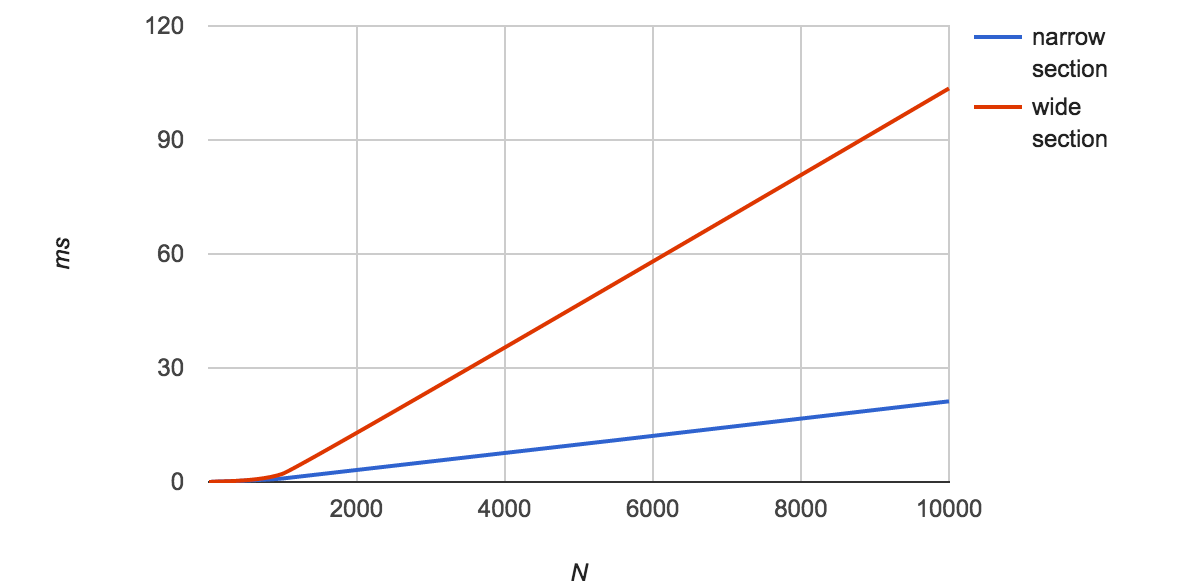
$ go test -bench=. -mutexprofile=mutex.out
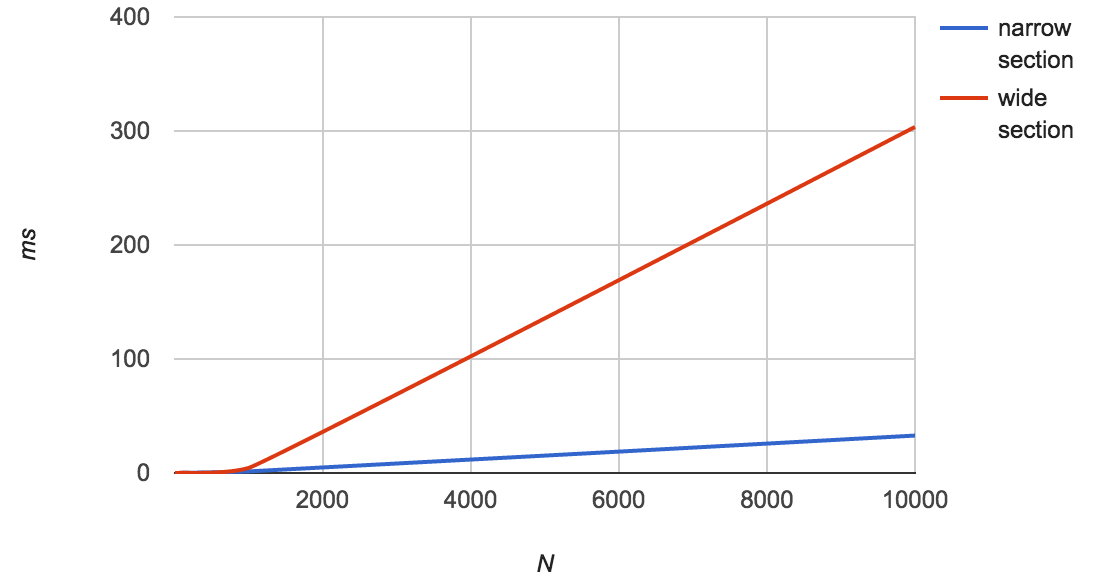
$ go tool pprof runtime.test mutex.out
Entering interactive mode (type "help" for commands)
(pprof) list
0 5.38s (flat, cum) 43.97% of Total
. . 34: mu.Lock()
. . 35: m[f]++
. 5.38s 36: mu.Unlock()
0 6.86s (flat, cum) 56.03% of Total
. . 53: mu.Lock()
. . 54: for _, f := range factors(i) {
. . 55: m[f]++
. . 56: }
. 6.86s 57: mu.Unlock()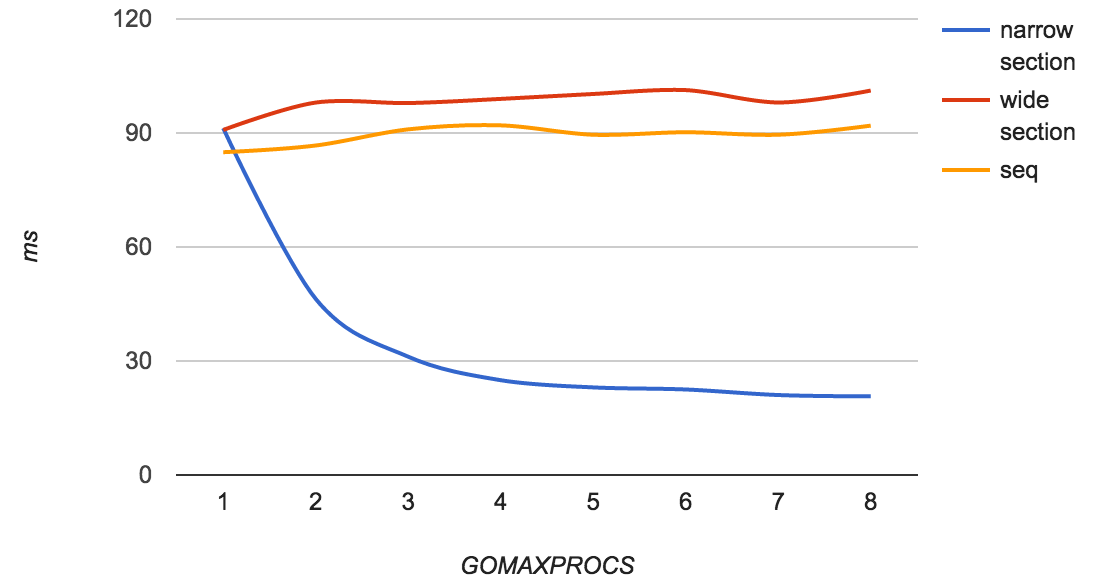
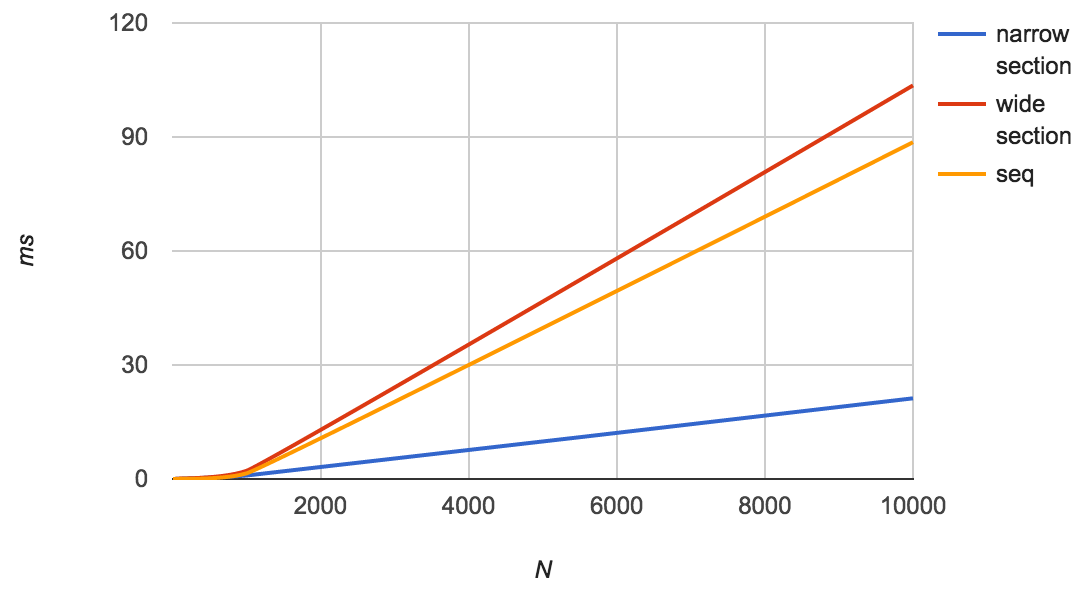
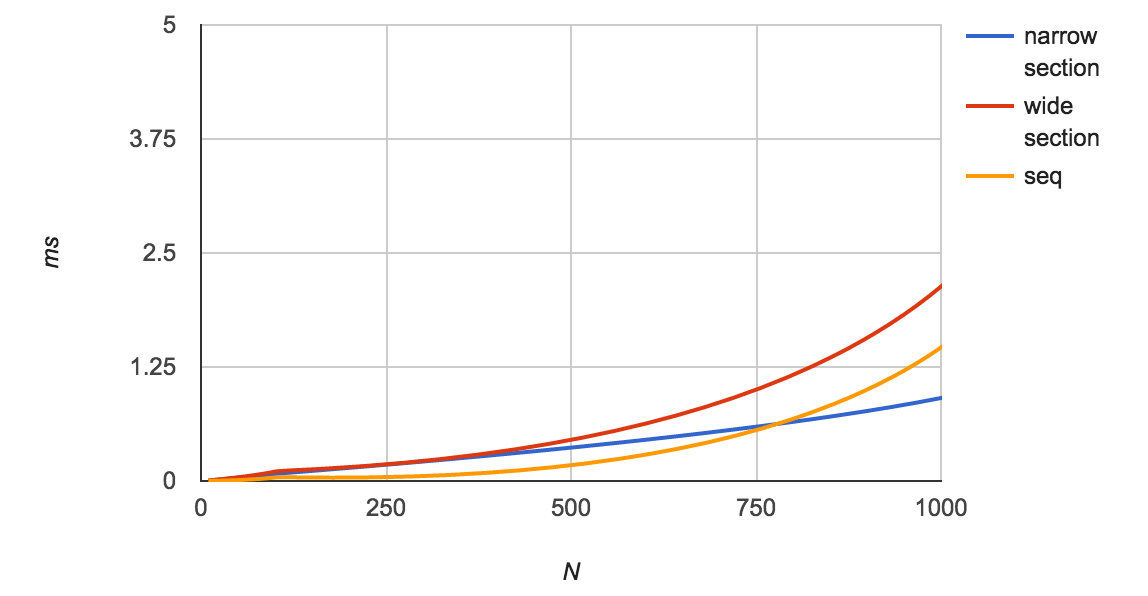
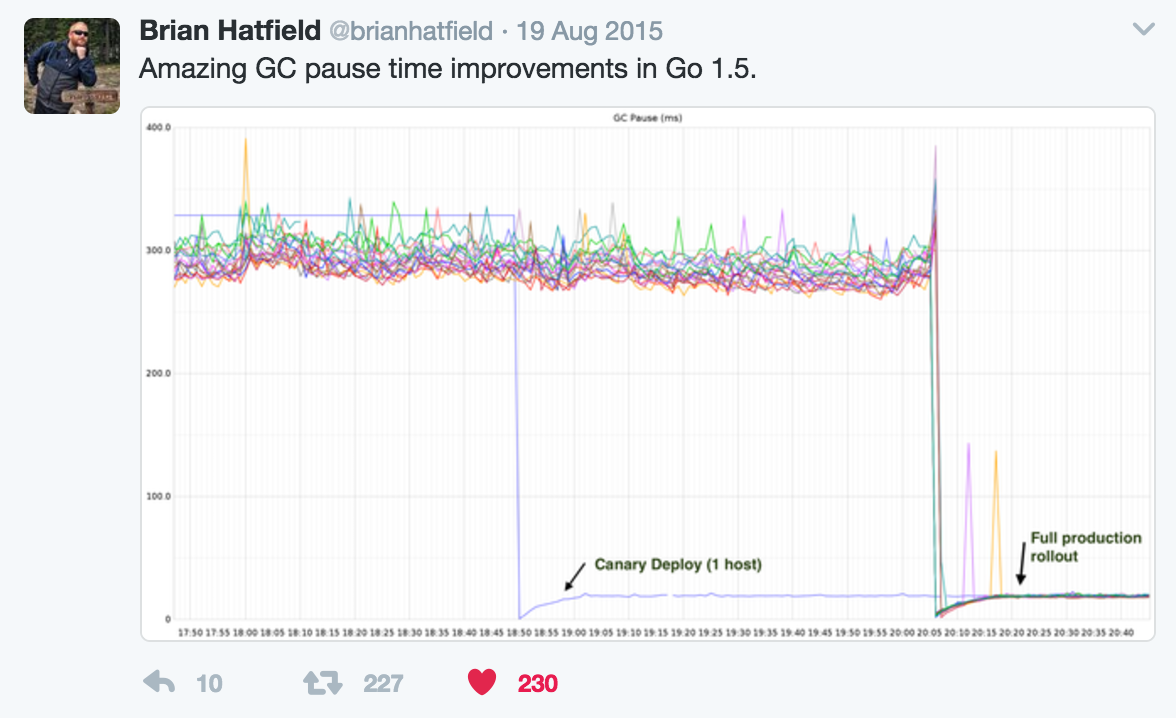
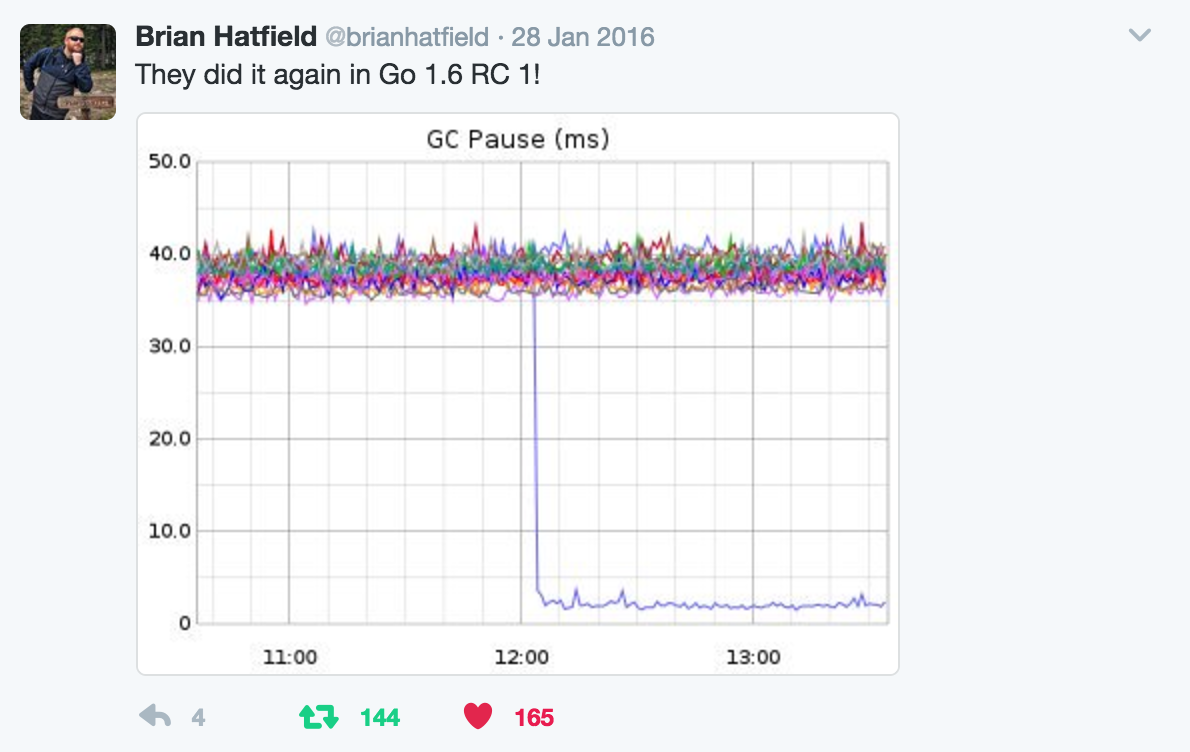
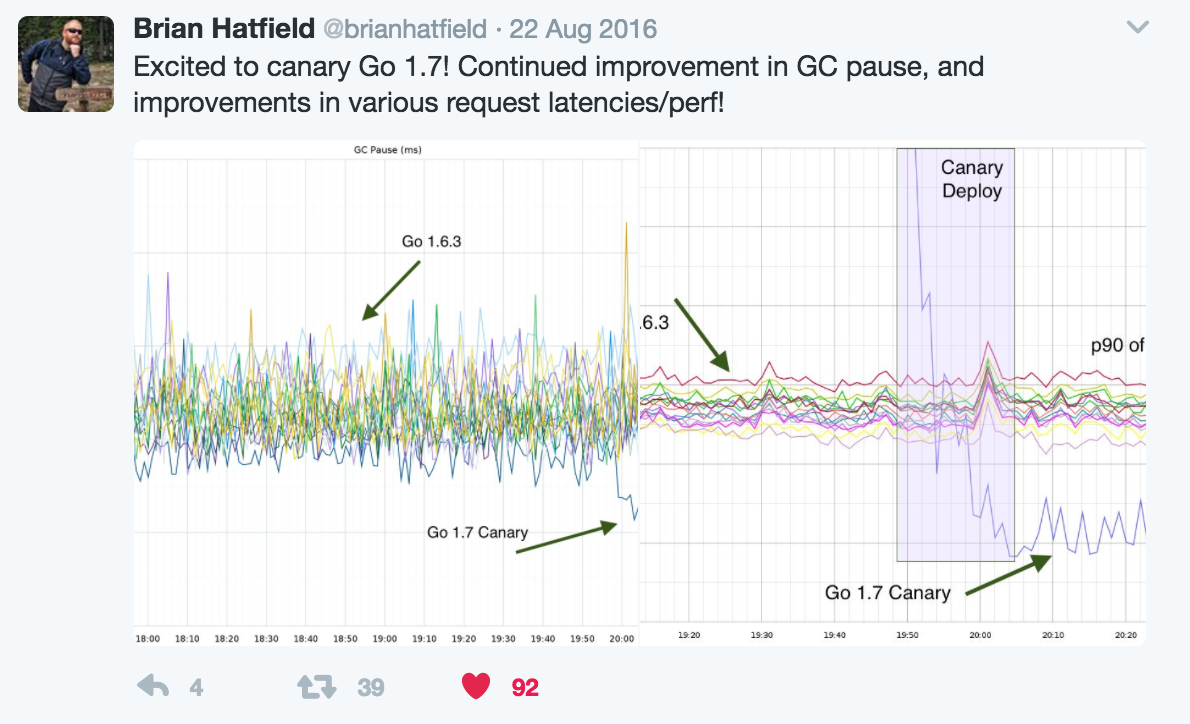
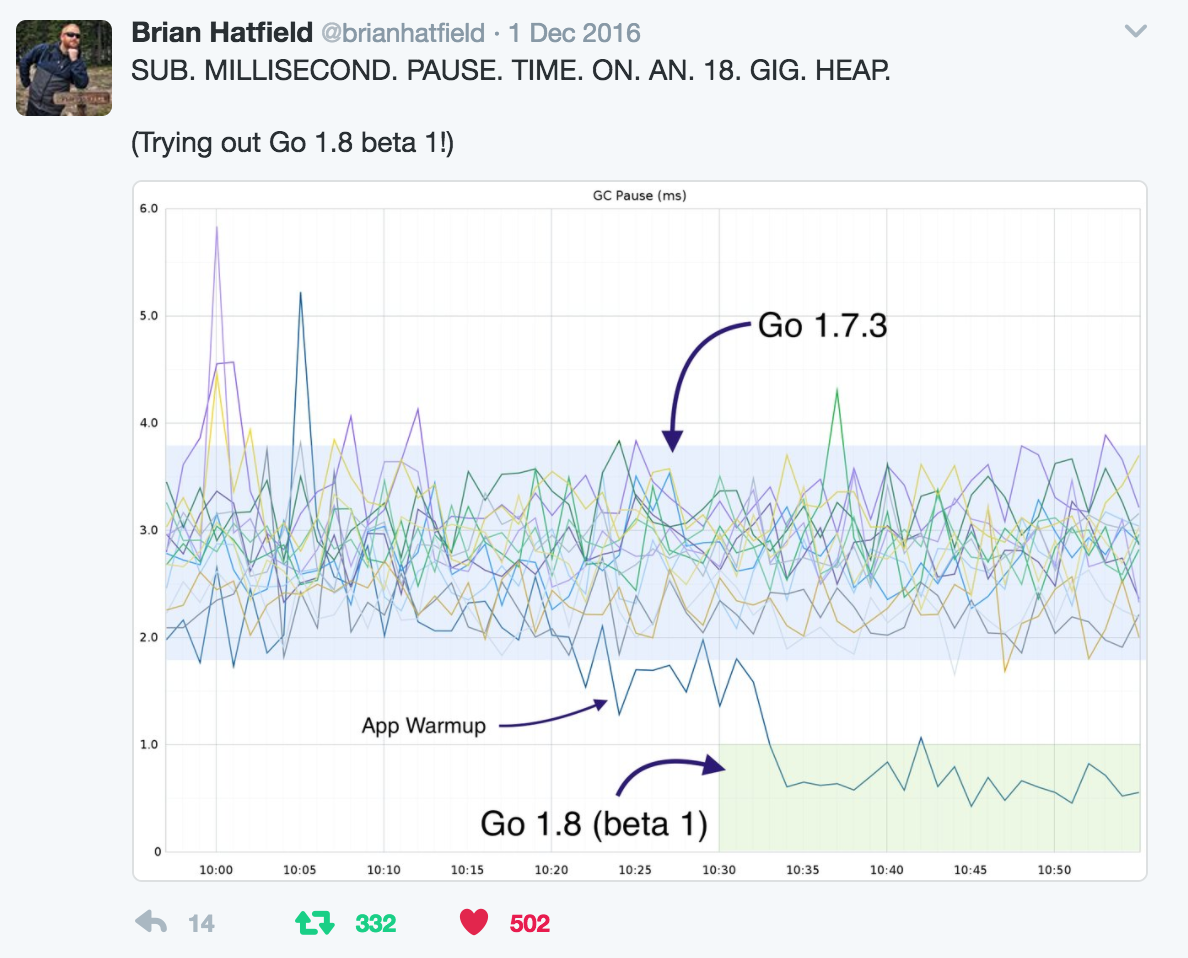
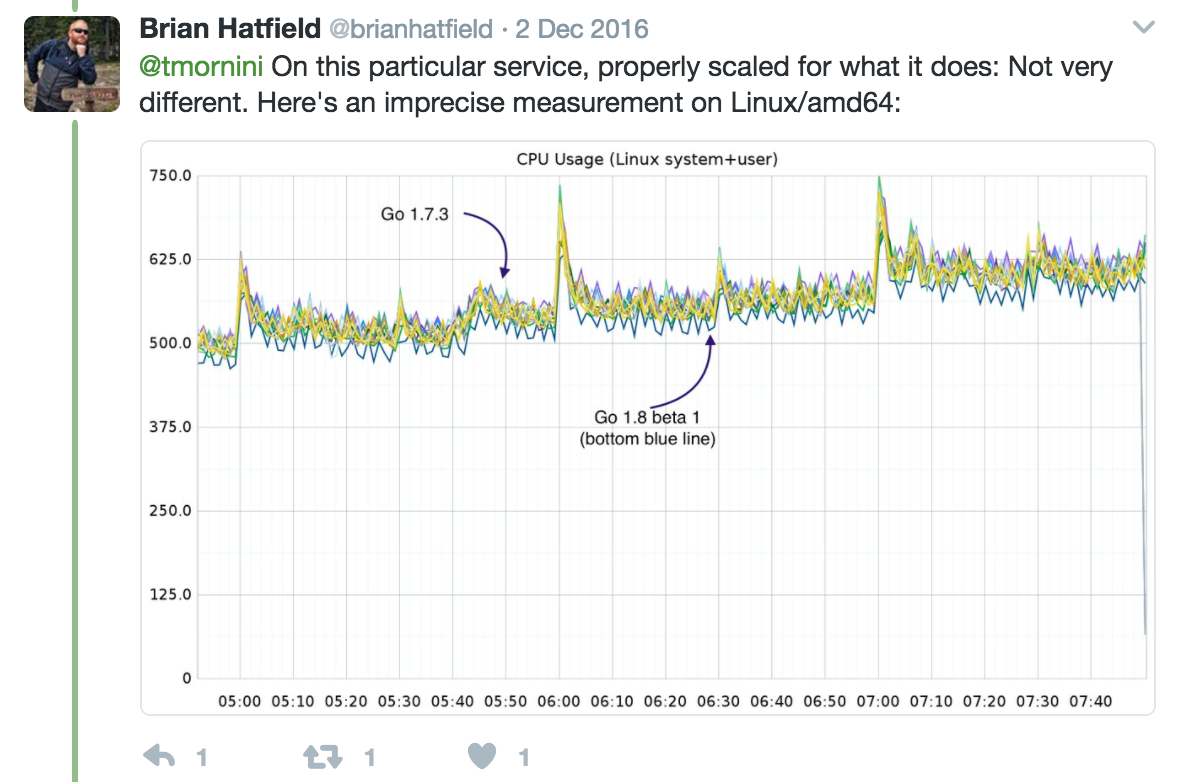
name old time/op new time/op delta Defer-4 101ns ± 1% 66ns ± 0% -34.73% (p=0.000 n=20+20) Defer10-4 93.2ns ± 1% 62.5ns ± 8% -33.02% (p=0.000 n=20+20) DeferMany-4 148ns ± 3% 131ns ± 3% -11.42% (p=0.000 n=19+19)
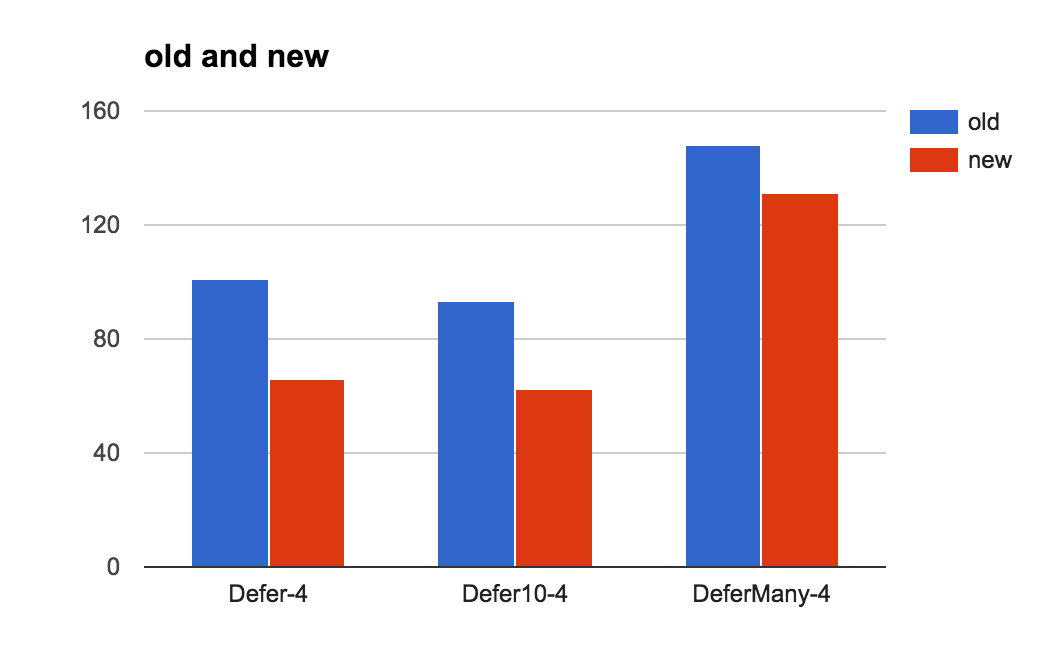
name old time/op new time/op delta CgoNoop-8 93.5ns ± 0% 51.1ns ± 1% -45.34% (p=0.016 n=4+5)
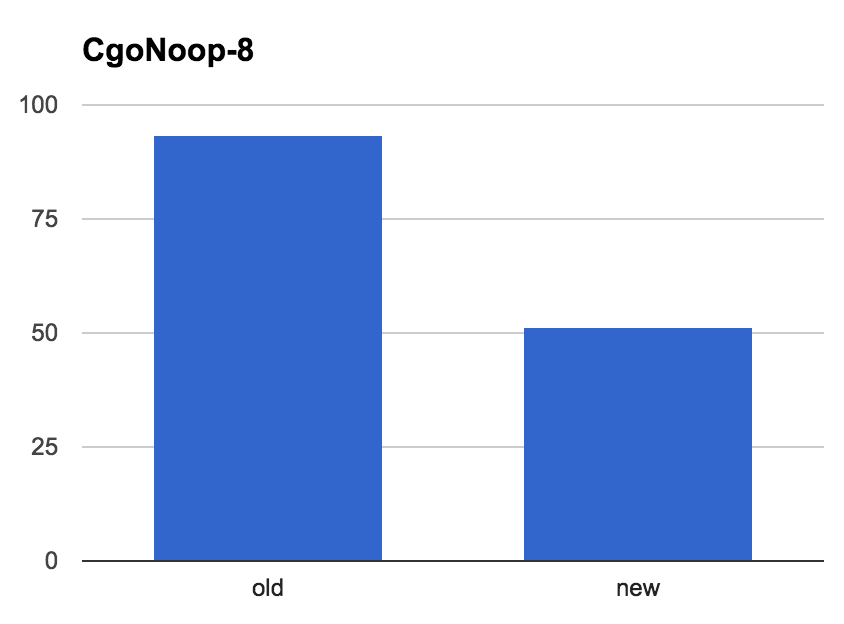
Source: dave.cheney.net
41Exercise:
Given a slice of Person
var p []Person
Print the slice sorted by name, age, and SSN.
sort.Sort(byName(p)) sort.Sort(byAge(p)) sort.Sort(bySSN(p))
Easy, right?
43Well, you forgot about this part.
type byName []Person func (b byName) Len() int { return len(b) } func (b byName) Less(i, j int) bool { return b[i].Name < b[j].Name } func (b byName) Swap(i, j int) { b[i], b[j] = b[j], b[i] } type byAge []Person func (b byAge) Len() int { return len(b) } func (b byAge) Less(i, j int) bool { return b[i].AgeYears < b[j].AgeYears } func (b byAge) Swap(i, j int) { b[i], b[j] = b[j], b[i] } type bySSN []Person func (b bySSN) Len() int { return len(b) } func (b bySSN) Less(i, j int) bool { return b[i].SSN < b[j].SSN } func (b bySSN) Swap(i, j int) { b[i], b[j] = b[j], b[i] }
Since Go 1.8 you can simply write this:
sort.Slice(p, func(i, j int) bool { return p[i].Name < p[j].Name }) sort.Slice(p, func(i, j int) bool { return p[i].AgeYears < p[j].AgeYears }) sort.Slice(p, func(i, j int) bool { return p[i].SSN < p[j].SSN })
Also new SliceStable and SliceIsSorted.
N=1 go test -bench=.
BenchmarkSortSort-8 10000000 145 ns/op
BenchmarkSortSlice-8 10000000 190 ns/op
N=10 go test -bench=.
BenchmarkSortSort-8 2000000 918 ns/op
BenchmarkSortSlice-8 1000000 1776 ns/op
N=100 go test -bench=.
BenchmarkSortSort-8 100000 16588 ns/op
BenchmarkSortSlice-8 50000 39035 ns/op
N=1000 go test -bench=.
BenchmarkSortSort-8 5000 320951 ns/op
BenchmarkSortSlice-8 3000 446677 ns/op
N=10000 go test -bench=.
BenchmarkSortSort-8 500 3644480 ns/op
BenchmarkSortSlice-8 300 4962263 ns/op
N=100000 go test -bench=.
BenchmarkSortSort-8 30 43573572 ns/op
BenchmarkSortSlice-8 20 60861706 ns/op
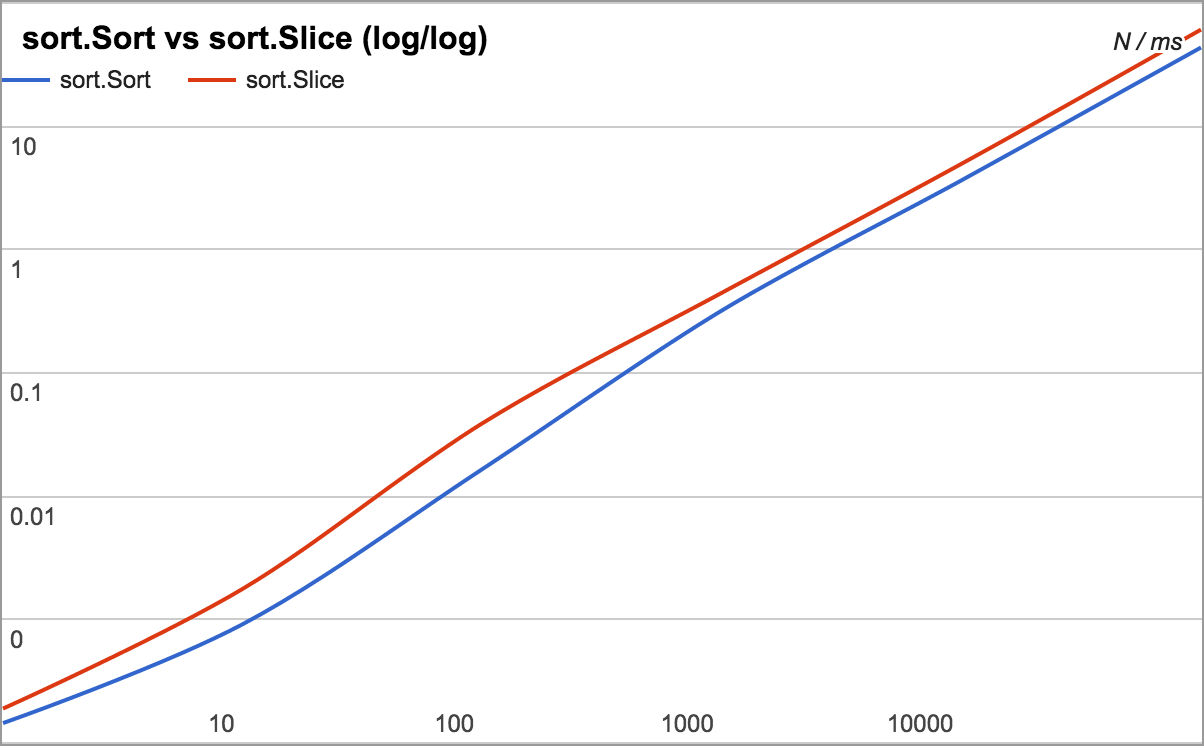
Define a plugin:
package main import "fmt" var V int func F() { fmt.Printf("Hello, number %d\n", V) }
Then build it:
go build -buildmode=plugin
Note: This currently works only on Linux.
49p, err := plugin.Open("plugin_name.so") if err != nil { panic(err) } v, err := p.Lookup("V") if err != nil { panic(err) } f, err := p.Lookup("F") if err != nil { panic(err) } *v.(*int) = 7 f.(func())() // prints "Hello, number 7"
Demo video: twitter.com/francesc
Source code: github.com/campoy/golang-plugins
51
Added Shutdown method to http.Server.
Example:
Call Shutdown when a signal is received:
// subscribe to SIGINT signals quit := make(chan os.Signal) signal.Notify(quit, os.Interrupt) srv := &http.Server{Addr: ":8080", Handler: http.DefaultServeMux} go func() { <-quit log.Println("Shutting down server...") if err := srv.Shutdown(context.Background()); err != nil { log.Fatalf("could not shutdown: %v", err) } }()
Check why the server stopped.
http.HandleFunc("/", handler) err := srv.ListenAndServe() if err != http.ErrServerClosed { log.Fatalf("listen: %s\n", err) } log.Println("Server gracefully stopped")
http.Response now satisfies the http.Pusher interface.
type Pusher interface {
Push(target string, opts *PushOptions) error
}A simple example:
func rootHandler(w http.ResponseWriter, r *http.Request) { if p, ok := w.(http.Pusher); ok { err := p.Push("/style.css", nil) if err != nil { log.Printf("could not push: %v", err) } } fmt.Fprintln(w, html) }
// +build ignore,OMIT
package main
import (
"fmt"
"go/build"
"log"
"net/http"
"path/filepath"
)
var cert, key string
func init() {
pkg, err := build.Import("golang.org/x/talks/content/2017/state-of-go/stdlib/http2", ".", build.FindOnly)
if err != nil {
log.Fatal(err)
}
cert = filepath.Join(pkg.Dir, "cert.pem")
key = filepath.Join(pkg.Dir, "key.pem")
}
func main() { http.HandleFunc("/", rootHandler) http.HandleFunc("/style.css", cssHandler) go func() { log.Fatal(http.ListenAndServeTLS("127.0.0.1:8081", cert, key, nil)) }() log.Fatal(http.ListenAndServe("127.0.0.1:8080", nil)) }
func rootHandler(w http.ResponseWriter, r *http.Request) {
if p, ok := w.(http.Pusher); ok { // HL
err := p.Push("/style.css", nil) // HL
if err != nil {
log.Printf("could not push: %v", err)
}
}
fmt.Fprintln(w, html)
}
func cssHandler(w http.ResponseWriter, r *http.Request) {
fmt.Fprintln(w, css)
}
const (
html = `
<html>
<head>
<link rel="stylesheet" href="/style.css">
<title>HTTP2 push test</title>
</head>
<body>
<h1>Hello</h1>
</body>
</html>
`
css = `
h1 {
color: red;
text-align: center;
text-shadow: green 0 0 40px;
font-size: 10em;
}
`
)
HTTP: localhost:8080
HTTP/2: localhost:8081
HTTP

HTTP/2

Since Go 1.7:
Since Go 1.8:

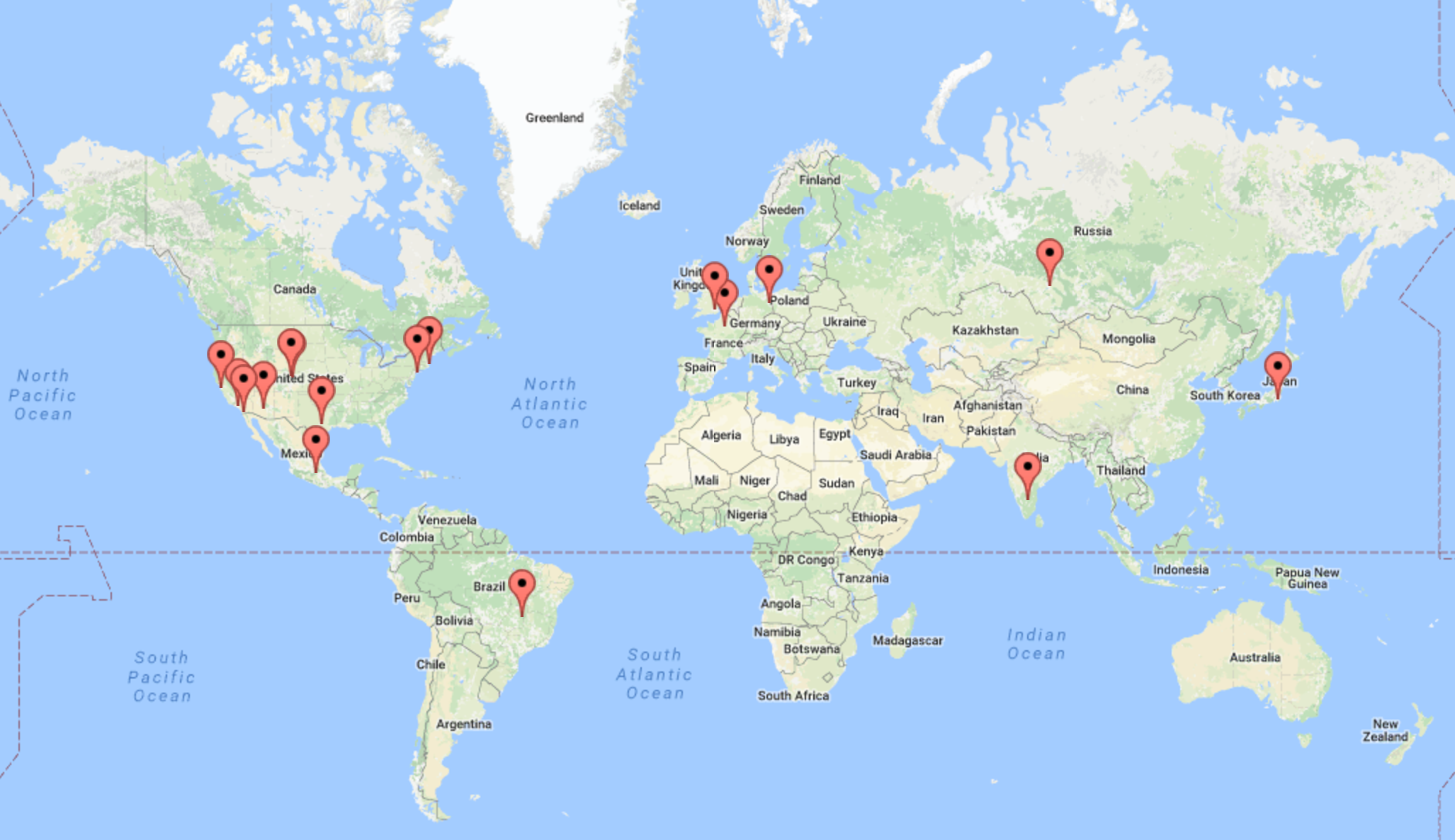
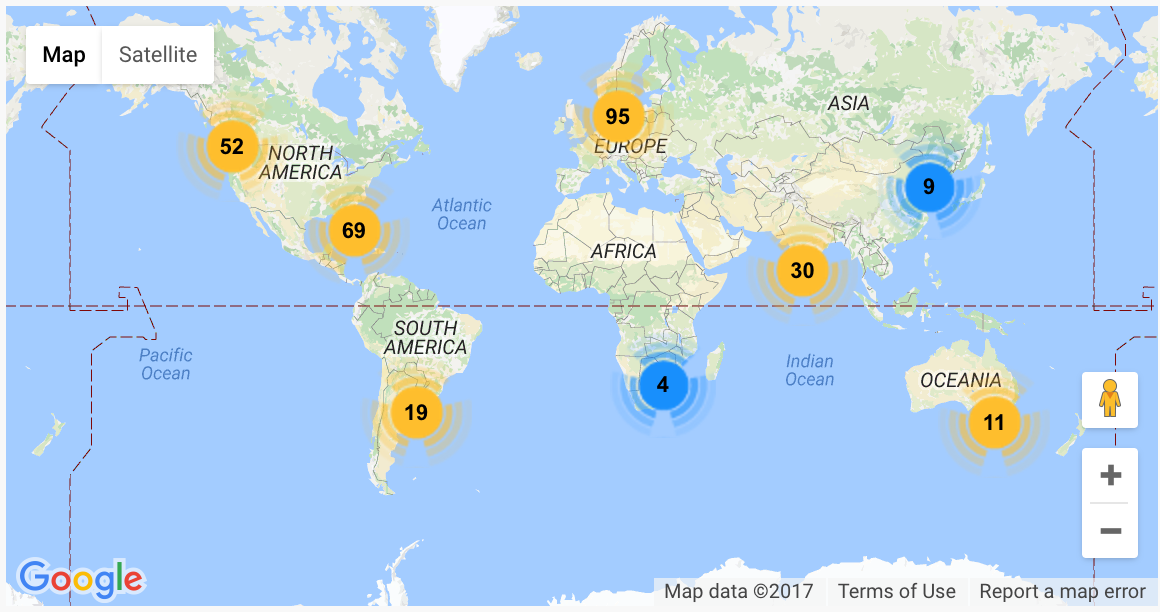
Go 1.8 ships soon!
Go meetups are organising to hold a release party on the 16th of February.
